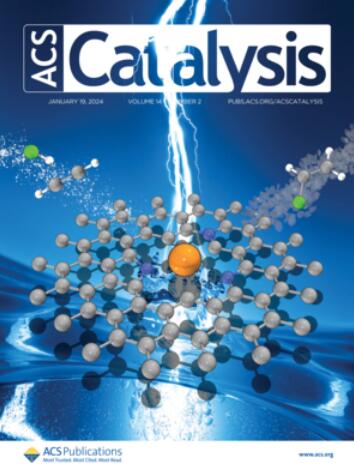Unraveling Reaction Pathways in CO2 Hydrogenation to Methanol at Metal-Oxide Interfaces
IF 13.1
1区 化学
Q1 CHEMISTRY, PHYSICAL
引用次数: 0
Abstract
The efficiency of methanol synthesis from CO2 hydrogenation is primarily governed by the metal/oxide interface of the catalyst. Identifying active interfaces and their associated reaction pathways is therefore a crucial objective in catalyst design. We here report the use of well-defined Pd nanocrystals to produce catalysts for systematically investigating the impact of metal/oxide interfaces on CO2 hydrogenation. Catalytic measurements revealed substantial variations in activity across different metal/oxide interfaces, with Pd supported on reducible oxides (TiO2, CeO2, and In2O3) exhibiting significantly higher activity than Pd on nonreducible supports (SiO2 and Al2O3). Methanol selectivity also varied notably, with Pd/In2O3 achieving a methanol selectivity of 95%, far exceeding the performance of other Pd catalysts (below 45%). Experimental and DFT results showed that Pd/In2O3 facilitates the direct hydrogenation of CO2 to methanol via a formate-intermediate pathway, whereas Pd/TiO2 and Pd/CeO2 proceed through dual pathways involving both formate and CO intermediates. These distinctions in reaction pathways stem from the nature of Pd–metal oxide interfacial sites and the presence of oxygen vacancies. These findings highlight the critical role of metal/oxide interfaces in dictating reaction pathways and controlling methanol productivity during CO2 hydrogenation, offering valuable insights for designing efficient catalysts for methanol production from CO2.

金属-氧化物界面上CO2加氢制甲醇反应途径的揭示
CO2加氢合成甲醇的效率主要取决于催化剂的金属/氧化物界面。因此,确定活性界面及其相关的反应途径是催化剂设计的关键目标。我们在此报告了使用定义良好的钯纳米晶体来生产催化剂,以系统地研究金属/氧化物界面对CO2加氢的影响。催化测量显示,钯在不同金属/氧化物界面上的活性存在显著差异,钯负载在可还原氧化物(TiO2、CeO2和In2O3)上的活性明显高于Pd负载在不可还原载体(SiO2和Al2O3)上的活性。甲醇选择性也有显著的变化,Pd/In2O3的甲醇选择性达到95%,远远超过其他Pd催化剂的性能(低于45%)。实验和DFT结果表明,Pd/In2O3通过甲酸-中间体途径促进CO2直接加氢成甲醇,而Pd/TiO2和Pd/CeO2则通过甲酸和CO中间体的双重途径进行加氢。这些反应途径的差异源于钯金属氧化物界面位置的性质和氧空位的存在。这些发现强调了金属/氧化物界面在CO2加氢过程中决定反应途径和控制甲醇生产率方面的关键作用,为设计有效的CO2制甲醇催化剂提供了有价值的见解。
本文章由计算机程序翻译,如有差异,请以英文原文为准。
求助全文
约1分钟内获得全文
求助全文
来源期刊

ACS Catalysis
CHEMISTRY, PHYSICAL-
CiteScore
20.80
自引率
6.20%
发文量
1253
审稿时长
1.5 months
期刊介绍:
ACS Catalysis is an esteemed journal that publishes original research in the fields of heterogeneous catalysis, molecular catalysis, and biocatalysis. It offers broad coverage across diverse areas such as life sciences, organometallics and synthesis, photochemistry and electrochemistry, drug discovery and synthesis, materials science, environmental protection, polymer discovery and synthesis, and energy and fuels.
The scope of the journal is to showcase innovative work in various aspects of catalysis. This includes new reactions and novel synthetic approaches utilizing known catalysts, the discovery or modification of new catalysts, elucidation of catalytic mechanisms through cutting-edge investigations, practical enhancements of existing processes, as well as conceptual advances in the field. Contributions to ACS Catalysis can encompass both experimental and theoretical research focused on catalytic molecules, macromolecules, and materials that exhibit catalytic turnover.
 求助内容:
求助内容: 应助结果提醒方式:
应助结果提醒方式:


